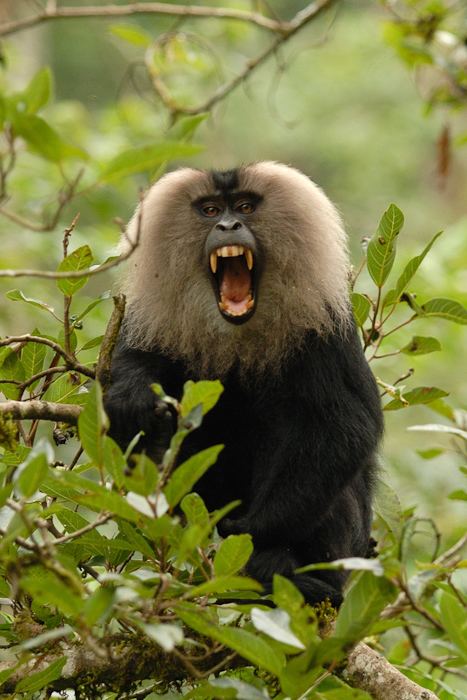Genus Macaca Scientific name Macaca silenus Mass 2 – 10 kg (Adult) Higher classification Macaque | Phylum Chordata Family Cercopithecidae Species M. silenus Lifespan 20 years (In the wild) Gestation period 183 days | |
 | ||
Length 42 – 61 cm (Adult, Head and body) Similar Macaque, Primate, Southern pig‑tailed macaque, Nilgiri langur, Crab‑eating macaque | ||
Lion tailed macaque behaviour
The lion-tailed macaque (Macaca silenus), or the wanderoo, is an Old World monkey endemic to the Western Ghats of South India.
Contents

Physical characteristics

The hair of the lion-tailed macaque is black. Its outstanding characteristic is the silver-white mane which surrounds the head from the cheeks down to its chin, which gives this monkey its German name Bartaffe - "beard ape". The hairless face is black in colour. With a head-body length of 42 to 61 cm and a weight of 2 to 10 kg, it ranks among the smaller macaques. The tail is medium in length, about 25 cm, and has a black tuft at the end, similar to a lion's tail. The male's tail-tuft is more developed than that of the female.

Gestation is approximately six months. The young are nursed for one year. Sexual maturity is reached at four years for females, and six years for males. The life expectancy in the wild is approximately 20 years, while in captivity is up to 30 years.
Behaviour

The lion-tailed macaque is a diurnal rainforest dweller. It is a good climber and spends a majority of its life in the upper canopy of tropical moist evergreen forests. Unlike other macaques, it avoids humans. In group behavior, it is much like other macaques; it lives in hierarchical groups of usually 10 to 20 animals, which consist of few males and many females. It is a territorial animal, defending its area first with loud cries towards the invading troops. If this proves to be fruitless, it brawls aggressively.
Lion-tailed macaque behaviour is characterized by typical patterns such as arboreal living, selectively feeding on a large variety of fruit trees, large interindividual spaces while foraging, and time budgets with high proportion of time devoted to exploration and feeding. It primarily eats indigenous fruits, leaves, buds, insects and small vertebrates in virgin forest, but can adapt to rapid environmental change in areas of massive selective logging through behavioural modifications and broadening of food choices to include fruits, seeds, shoots, pith, flowers, cones, mesocarp, and other parts of many nonindigenous and pioneer plants. In the forests of Kerala they were observed preying on nestling and eggs of pigeons.
Population
A recent assessment for IUCN reports 3000-3500 of these animals live scattered over several areas in Kerala. The lion-tailed macaque ranks among the rarest and most threatened primates. Their range has become increasingly isolated and fragmented by the spread of agriculture and tea, coffee, teak and cinchona, construction of water reservoirs for irrigation and power generation, and human settlements to support such activities. They do not live, feed or travel through plantations. Destruction of their habitat and their avoidance of human proximity have led to the drastic decrease of their population.
From 1977 to 1980, public concern about the endanged status of lion-tailed macaque became the focal point of Save Silent Valley, India's fiercest environmental debate of the decade. From 1993 to 1996, 14 troops were observed in Silent Valley National Park, Kerala, one of the most undisturbed viable habitats left for them.
A self-sustainable single population of 32 groups of lion-tailed macaques occurred in Sirsi-Honnavara, Karnataka, the northernmost population of the species. A local census concluded in 2007, conducted in the Theni District of Tamil Nadu, put their numbers at around 250, which was considered encouraging, because till then, no lion-tailed macaques had been reported in that specific area. The species is also prominently found in the Papanasam part of the Kalakkad Mundanthurai Tiger Reserve of Tirunelveli district of Tamil Nadu. Many zoos take part in breeding programs which help to secure the survival of this species. About 338 of these macaques are reported to live in zoos. However, it is no longer on ‘The World’s 25 Most Endangered Primates’ list, after the international body compiling it determined that the local governments in southern India had acted positively to protect it.
